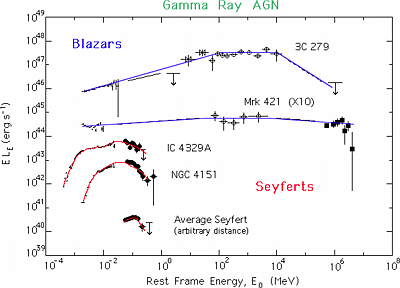
Requirements:
2.3 EXTRAGALACTIC ASTROPHYSICS
2.3.1 SEYFERTS
Prior to the launch of the CGRO, only four AGN had been detected significantly
at energies above 100 keV; these are NGC 4151, 3C 273, Centaurus A, and
MCG 8-11-11. The CGRO instruments clearly separate the high-energy emission
of AGN into a gamma-ray blazar class discovered by EGRET and characterized
by strong emission above 30 MeV and a Seyfert class seen by OSSE below
a few hundred keV with softer spectra which cut off below the EGRET band.
The blazar AGN are generally identified with core-dominant radio sources
such as flat-spectrum quasars and BL Lac objects. The distinction between
the blazars and Seyfert classes of AGN is thought to be the importance
of beamed, relativistic jet emission which presumably dominates in blazars
relative to emissions associated with an accretion disk which dominate
in Seyfert AGN. The X-ray emission of Seyferts can be described by both
thermal and nonthermal mechanisms. Key measurements in hard X-rays and
gamma rays are needed to resolve the thermal/nonthermal nature of the energy
source.

Figure 2.3.1 - Nu-FNu of gamma-ray detected Seyferts & blazars which form quite distinct classes of gamma-ray AGN.
In nonthermal scenarios, the creation of pairs through g-g -> e+-e-
interactions significantly alters the emerging high-energy spectrum. Under
certain source density-luminosity conditions, broadened pair annihilation
features would be observable. In addition, the continuum spectral shape
above100 keV should be different for nonthermal vs. thermal emission mechanisms.
OSSE has detected significant emission above 50 keV from 14 Seyferts. The
average spectrum above 50 keV is adequately described by either a power
law with energy spectra index a = 2.4 or by a simple exponential with an
e-folding energy of 45 keV. Correlated observations with Ginga and/or ROSAT
on specific bright sources provides more physical interpretation of the
emission. In the case of NGC 4151, the brightest Seyfert detected by OSSE,
the spectrum is clearly cutoff. IC 4329A is a more representative Seyfert
1 AGN but is significantly weaker than NGC 4151 in the OSSE band. Combined
analysis of IC 4329A data from Ginga, ROSAT, and OSSE require no strong
cutoff as in NGC 4151 with the cutoff limit constrained-only to be above
250 keV; consequently both thermal and nonthermal models are acceptable.
A simple model of Comptonization in a relativistic, optically-thin, thermal
corona above the surface of an accretion disk provides a good description
of the observed spectrum.